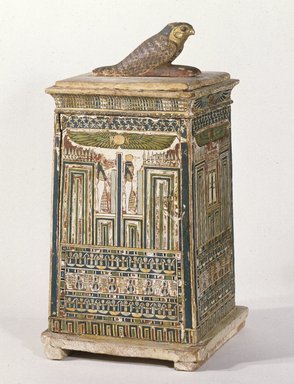
Medium: Wood, stucco, pigment
Geograhical Locations:
Dates:ca. 380-30 B.C.E.
Dimensions: 20 1/16 x 8 11/16 x 9 7/16 in. (51 x 22 x 24 cm)
Collections:
Museum Location: Funerary Gallery 3, Martha A. and Robert S. Rubin Gallery, 3rd Floor
Exhibitions:
Accession Number: 37.1390E
Image: 37.1390E_reference_SL1.jpg,
Catalogue Description: One box of wood, painted and gilded. Decorated with doors and a shrine to represent the same within an enclosure. The upper edge bears a cavetto cornice; the lid is surmounted by a gilded and painted falcon. The front bears the representation of the shrine within an enclosure; surmounted by a winged sun disk, just below the cornice. The left side bears the figures of two of the sons of Horus; Duamutef and Imsety, standing above the same stylized enclosure as is pictured on the front. On the right side we have the other two sons of Horus shown-Kebehsenuef and Hapi. They too stand on the stylized enclosure. On the rear, flanked by two doors is a Djed pillar caped by the Atef and flanked by two "blood of Isis" signs. All sides are surmounted by the winged sun disc. Below each vignette runs a frieze of signs. Rich polychrome is used. Green, blue, red brown, yellow, white, black, and of course, gilding are seen. The box rests on a projecting base which in turn is supported by two wooden slats, front and rear. Condition: The rear exhibits a large disfiguring crack, running from just under the cornice to the base. Part of the split panel has warped inward. Right and left sides have experienced some paint loss due to rubbing and exhibit areas of cracking of gesso (left side especially). Left side bears a large damage on the right hand margin. The fragments have been solidified and at some past date and are adhering in a "clump". Most all of the seams are "sprung", revealing the dwelling technique and the fact that the box was composed from many smaller fragments of wood. The lid has lost much gesso from this front edge, but has survived fairly well. A great deal of yellow paint has been rubbed off. The base is missing a great deal of both paint and gesso. Especially at the left rear and left front edges in this noticeable. A crackle pattern covers the entire surface. The box was meant to contain a canopic jar.